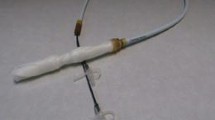Abstract
Background
Research into minimally invasive techniques is worthwhile for greater acceptance in bariatric surgery, a useful first step being to evaluate the combination of these with current procedures. We suggest that intragastric balloon (IGB) can be performed with hyaluronic acid (HA) injections at the level of the gastroesophageal junction.
Methods
A submucosal restriction is created by circular injection of an absorbable material within a defined area based on endoscopic anatomy. We included 101 patients in a prospective multicenter randomized trial, with average body mass index (BMI) 33.4 (range 27–44), treated from April 2010 to April 2012 by IGB and/or HA injection, sequentially, and followed for two more years. Patients were divided into group 1 (IGB alone), group 2 (IGB followed by HA at IGB removal, at 6 months), and group 3 (HA and IGB at 6 months).
Results
BMI loss at 6 months was inferior in the HA group (32 patients) compared with the IGB groups (68 patients) (2.1 ± 0.4 versus 3.4 ± 0.3, p < 0.05). The efficacy of IGB alone compared with combined treatments (groups 2 and 3) was significantly inferior at 18 months only, but the impact of the treatment sequence (HA before or after IGB) on BMI loss was not statistically significant, although in favor of HA first.
Conclusions
This study did not demonstrate the efficacy of HA injections as an obesity treatment.



Similar content being viewed by others
References
Belachew M, Legrand MJ, Vincent V, et al. Laparoscopic adjustable gastric banding. World J Surg. 1998;22:955–63.
O’Brien PE, McPhail T, Chaston TB, et al. Systematic review of medium-term weight loss after bariatric operations. Obes Surg. 2006;16(8):1032–40.
Baltasar A, Serra C, Perez N, et al. Laparoscopic sleeve gastrectomy: a multi-purpose bariatric operation. Obes Surg. 2005;15:1124–8.
Wittgrove AC, Clark GW. Laparoscopic gastric bypass Roux en Y—500 patients: technique and results with 3–60 months follow-up. Obes Surg. 2000;3:233–9.
Dargent J. The patient barrier to growth of bariatric surgery: another French paradox? Obes Surg. 2007;17:287–91.
Alverdy JC, Prachand V, Flanagan B, et al. Bariatric surgery: a history of empiricism, a future in science. J Gastrointest Surg. 2009;13(3):465–77.
Busetto L, Dixon J, De Luca M, et al. Bariatric surgery in class I obesity. A position statement from the International Federation for the Surgery and Metabolic Disorders (IFSO). Obes Surg. 2014;24:487–519.
Weiner R, Gutberlet H, Bockhorn H. Preparation of extremely obese patients for laparoscopic gastric banding by gastric balloon therapy. Obes Surg. 1999;9:261–4.
Genco A, Bruni T, Doldi SB, et al. BioEnterics intragastric balloon: the Italian experience with 2,515 patients. Obes Surg. 2005;15:1161–4.
Moreno C, Closset J, Dugardeyns S, et al. Transoral gastroplasty is safe, feasible, and induces significant weight loss in morbidly obese patients: results of the second human pilot study. Endoscopy. 2008;40:406–13.
De Jonge C, Rensen SS, Verdam FJ, et al. Endoscopic duodenal-jejunal bypass liner rapidly improves type 2 diabetes. Obes Surg. 2013;9:1354–60.
Pleskow D, Rothstein R, Lo S, et al. Endoscopic full-thickness plication for the treatment of GERD: a multicenter trial. Gastrointest Endosc. 2004;59:163–71.
Johnson DA, Ganz R, Aisenberg J, et al. Endoscopic implantation of Enteryx for GERD treatment: 12 months results of a prospective multicenter trial. Am J Gastroenterol. 2003;98:1921–30.
Horgan S, Thompson K, Talamini M, et al. Clinical experience with a multifunctional, flexible surgery system for endolumenal, single-port, and NOTES procedures. Surg Endosc. 2011;25(2):586–92.
O’Connor KW, Lehman GA. Endoscopic placement of collagen at the lower oesophageal sphincter to inhibit gastroesophageal reflux: a pilot study of 10 medically intractable patients. Gastrointest Endosc. 1988;34:106–12.
Nocca D, Gagner M, Aggarwal R, et al. Is collagen a good banding material for outlet control of vertical gastroplasty? Preliminary study in pigs. Obes Surg. 2006;16:39–44.
Mittermair R, Keller C, Geibel J. Intragastric injection of botulinum toxin A for the treatment of obesity. Obes Surg. 2007;17:732–6.
Books J, Srivastava ED, Mathus-Vliegen EMH. One year adjustable intragastric balloons: results in 73 consecutive patients in the UK. Obes Surg. 2014;24(5):813–9.
Genco A, Cipriano M, Bacci V, et al. Intragastric balloon followed by diet vs intragastric balloon followed by another balloon: a prospective study on 100 patients. Obes Surg. 2010;20:1496–500.
Genco A, Maselli R, Frangella F, et al. Effect of consecutive intragastric balloon plus diet vs single BIB plus diet on eating disorders not otherwise specified (EDNOS) in obese patients. Obes Surg. 2013;23:2075–9.
Mathus-Vliegen EM, de Groot GH. Fasting and meal-induced CCK and PP secretion following intragastric balloon treatment for obesity. Obes Surg. 2013;23(5):622–33.
Marjoux S, Brochard C, Roman S, et al. Botulinum toxin injection for hypercontractile or spastic esophageal motility disorders: may high-resolution manometry help to select cases? Dis Esophagus. 2014. doi:10.1111/dote.12282.
Imaz I, Martinez-Cervell C, Garcia-Alvarez EE, et al. Safety and effectiveness of the intragastric balloon for obesity. Obes Surg. 2008;18:841–6.
Tai CM, Lin HY, Lien YC, et al. Effectiveness of intragastric balloon treatment for obese patients: one year follow-up after balloon removal. Obes Surg. 2013;23:2068–70.
Schauer P, Chand B, Brethauer S. The emerging field of endoluminal and transgastric bariatric surgery. Surg Endosc. 2007;21(3):347–56.
Emerging Technologies and Clinical Issues Committees of the ASMBS. American society for metabolic and bariatric surgery position statement on emerging endosurgical interventions for treatment of obesity. Surg Obes Relat Dis. 2009;5(3):297–98. doi:10.1016/j.soard.2009.02.001.
Ethical Approval
All procedures performed in the studies involving human participants were in accordance with the ethical standards of the institutional and/or national research committee and with the 1964 Helsinki Declaration and its later amendments or comparable ethical standards.
Informed Consent
Informed consent was obtained from all individual participants included in the study.
Conflict of Interest
The authors declare that they have no conflict of interest.
Author information
Authors and Affiliations
Corresponding author
Rights and permissions
About this article
Cite this article
Dargent, J., Mion, F., Costil, V. et al. Multicenter Randomized Study of Obesity Treatment with Minimally Invasive Injection of Hyaluronic Acid Versus and Combined with Intragastric Balloon. OBES SURG 25, 1842–1847 (2015). https://doi.org/10.1007/s11695-015-1648-0
Published:
Issue Date:
DOI: https://doi.org/10.1007/s11695-015-1648-0




